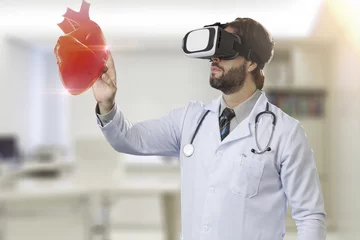Virtual and Augmented Reality (VR/AR) are two of the most exciting and rapidly-evolving technologies of our time. While they are often grouped together, they are actually quite different in terms of what they offer and how they work. In this blog, we will explore what VR and AR are, their potential applications, and some of the challenges that they face.
 |
| Vector virtual reality glass technology |
What is Virtual Reality?
Virtual Reality (VR) is a technology that creates a simulated environment that can be experienced as if it were real. VR typically involves the use of a headset or other device that covers the eyes, blocking out the real world and replacing it with a virtual one. Users can interact with the virtual environment in various ways, such as by using controllers or hand gestures.
One of the main benefits of VR is that it can create an immersive experience that can transport users to entirely new worlds. This makes it particularly useful for applications such as gaming, education, and training. For example, medical students can use VR to practice surgical procedures, while pilots can use it to simulate flying conditions.
 |
| Practice surgical procedures with VR |
What is Augmented Reality?
Augmented Reality (AR) is a technology that overlays digital information onto the real world. AR typically involves the use of a smartphone or tablet, which uses the camera to capture the user's surroundings and then overlays digital information onto the screen. This can include anything from text and images to 3D models and animations.
One of the main benefits of AR is that it can enhance the user's experience of the real world by adding new layers of information and interactivity. This makes it particularly useful for applications such as gaming, advertising, and navigation. For example, AR can be used to create interactive advertisements that allow users to engage with products in new ways.
Potential Applications of VR/AR:
The potential applications of VR and AR are vast and varied. Here are just a few examples:
Gaming: VR is already being used to create immersive gaming experiences, and AR has the potential to enhance traditional gaming by adding new layers of interactivity and information.
Education: VR and AR can be used to create immersive educational experiences, such as virtual field trips and science simulations.
Training: VR and AR can be used to train people in a wide variety of fields, such as medicine, aviation, and the military.
Advertising: AR can be used to create interactive advertisements that allow users to engage with products in new ways.
Navigation: AR can be used to create digital maps and overlays that provide real-time information about the user's surroundings.
Challenges and Limitations:
While the potential applications of VR and AR are exciting, there are also a number of challenges and limitations that need to be addressed. Some of these include:
Cost: VR and AR technology can be expensive, which can limit its accessibility for many people and organizations.
Comfort: VR can cause motion sickness and other discomfort for some users, which can limit its effectiveness.
Interaction: While VR and AR allow for new forms of interaction, they can also be more complex and difficult to use than traditional interfaces.
Technical limitations: VR and AR technology is still evolving, and there are limitations in terms of the quality of the graphics and the processing power required to create truly immersive experiences.
Conclusion:
Virtual and Augmented Reality are two of the most exciting and rapidly-evolving technologies of our time. While they are often grouped together, they are actually quite different in terms of what they offer and how they work. Despite the challenges and limitations, the potential applications of VR and AR are vast and varied, and we are only beginning to scratch the surface of what these technologies can do. As the technology continues to evolve and become more accessible, we can expect
by Sawan Kumar Roy

Comments
Post a Comment